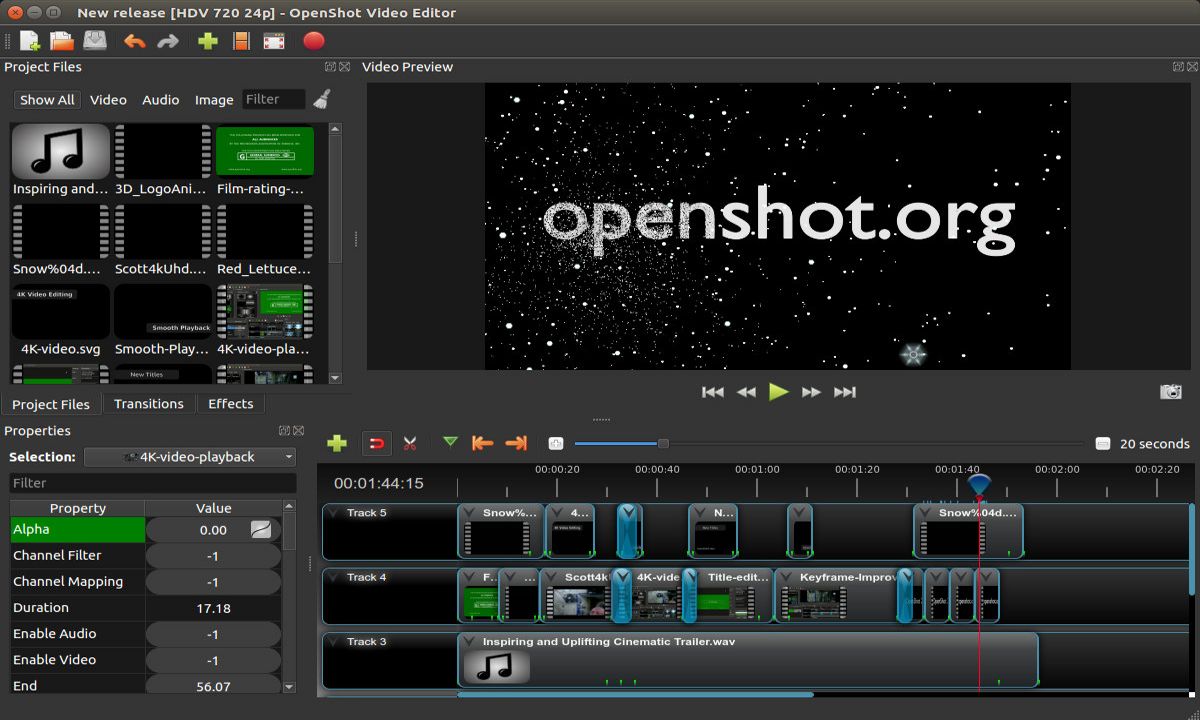
OpenShot Video Editor is a cross-platform non-linear video editing free software program.
After more than a year of development, the release of the new branch version of “OpenShot 3.0.0” has been published, a version in which work was done on the reworking of the code of various sections, with which great improvements in performance and optimization were achieved, among other things.
The editor features an intuitive and easy-to-use user interface that allows even novice users to edit videos. The program supports several dozen visual effects, allows you to work with multi-track timelines with the ability to move elements between them with the mouse, allows you to scale, crop, merge video blocks, ensure a smooth flow from one video to other, overlap translucent areas, etc.
Main new features of OpenShot 3.0.0
In this new version that comes from OpenShot 3.0.0 improved video playback performance in live preview, as well as fixed issues with frozen playback.
Another of the changes that we can find in OpenShot 3.0.0 is that it has redesigned video decoding engine, whose architecture has been modified to function correctly under conditions of packet loss or lack of time stamps, thereby support for various formats and codecs has been improved, including multi-streaming codecs like AV1. Improved playback duration and end-of-file detection under conditions of missing timestamps, bad metadata, and problematic encoding.
In addition to that, he video caching system has been redesigned, for caching, a separate background thread is involved, in which preemptive preparation of frames that may be needed during subsequent playback is performed.
It is also highlighted that support for caching with different playback speeds has been implemented (1X, 2X, 4X) and with playback in reverse. The settings offer new cache management options, as well as the ability to clear the entire cache.
La Fitting accuracy has been greatly improved in the timeline when trimming and moving clips and transitionss, because holding down the Shift key aligns the playhead with the edges of the clips.
Provided file-related sound wave data caching and in-project caching, making it possible to make the cache independent of user sessions and speed up sound wave rendering. sound in case of multiple cuts.
Has reduced memory consumption and fixed memory leaks, since the main objective of the work carried out is to adapt OpenShot to carry out many hours of rendering, for example, when processing long video sequences and surveillance camera recordings. To evaluate the optimizations, a 12-hour encoding was performed, which demonstrated the uniformity of memory consumption throughout the entire session.
Added the ability to export clips in batch mode, in which the files are divided into a series of clips, after which all these clips are exported at once using the original profile and format. For example, it's now possible to cut highlight clips from home videos and export those clips in one go as separate video files.
Of the other changes that stand out:
- The accuracy of matching the clip to the sound wave has been improved, thanks to the ability to scale the clip to a single frame.
- Faster clip cutting operation. Redesigned keyframe icons that are now clickable, filterable, and used to change the tween mode.
- Each video effect on the scale has its own color, and each transition effect has its own direction (fade in and out).
- Extended and optimized tools for working with a sound wave.
- Added support for exporting animated GIFs, MP3 (audio only), YouTube 2K, YouTube 4K, and MKV. Improved support for anamorphic video profiles (videos with non-square pixels).
- Animation templates adapted for use with the Blender 3 3.3D modeling system.
- Added new settings that determine the behavior when choosing file paths for import, open/save, and export. For example, when saving, you can use the project directory or the recently used directory.
- Provided correct alphabetical classification of data in languages other than English.
- Full support for High DPI displays, including 4K monitors.
- All icons, cursors and logos have been converted to vector format or saved in high resolution.
How to install OpenShot on Ubuntu and derivatives?
This new update is not in the official Ubuntu repositories, so you need to add your official repository, for this you will have to open a terminal and add the official repositories.
sudo add-apt-repository ppa:openshot.developers/ppa
We update the repositories
sudo apt-get update
And finally we install the video editor on our system.
sudo apt-get install openshot-qt
As well it is possible to download the application in an appimage format, for this we must download the following file from the terminal:
wget https://github.com/OpenShot/openshot-qt/releases/download/v3.0.0/OpenShot-v3.0.0-x86_64.AppImage
We give you execution permissions with
sudo chmod a+x OpenShot-v3.0.0-x86_64.AppImage
And we execute with:
./OpenShot-v3.0.0-x86_64.AppImage[
Or in the same way, they can run the application by double clicking on the downloaded file.